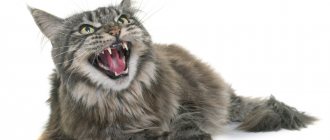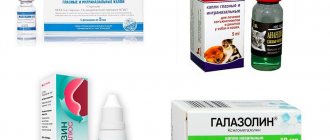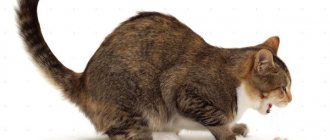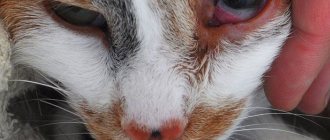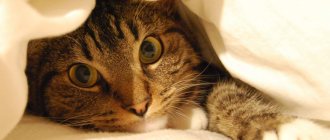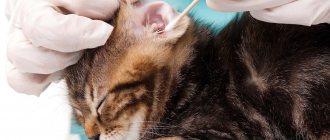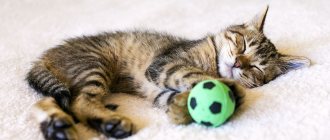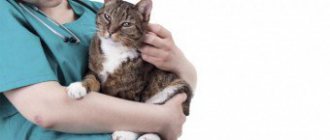What is a cat's fat tail?
A cat's fat tail is scientifically called a “primordial pouch,” which means a genetic tendency in some cat breeds to form a fold of skin on the abdomen, between the hind legs.
A small hanging tail is considered normal for cats if it is elastic, soft to the touch, does not cause pain and its size does not exceed 5 cm.
In felinology, there are several theories that explain this anatomical feature in cats:
- The inguinal skin fold is a “depot” for fat deposits, which are consumed during prolonged fasting of a cat, which allows animals to survive in the most difficult circumstances. Fat deposits in cats are especially noticeable during the winter cold.
- The fat tail acts as a repository of excess elastic skin, which is actively used when jumping high, long, while climbing trees or when entering narrow crevices, when the cat needs to stretch out “in line” to get to the desired place.
- A hanging belly in cats is an additional means of protecting internal organs during fights and fights with relatives. Cats tend to deliver powerful blows to the enemy with their hind legs, and an additional layer of skin will protect the vulnerable belly from damage to internal organs.
All domestic and wild cats have a fat tail, but in some it is more pronounced due to breed or physiological characteristics, in others it is less pronounced.
In spring and summer, the size of the saggy tummy in cats is significantly reduced, and in late autumn and winter the fat tail grows again.
Treatment
So, all cats have a primordial sac. If it sags by about 3-5 cm, this is considered normal. If there are no other symptoms of the animal's disease, there is no need to worry.
It is necessary to take action only if the total weight of the pet significantly exceeds the norm. You should weigh your pet and compare the data with the height and weight standards established for this breed.
You can also determine obesity yourself: you need to look at the cat from above, and then feel its sides. When palpating, the ribs should be palpable, and the stomach should not stick out to the sides.
You might be interested in: How to properly remove an ingrown claw from a cat?
Obesity negatively affects the functioning of all internal organs of the animal. It can lead to a number of dangerous diseases. Therefore, an animal that has been diagnosed with obesity needs to be put on a diet.
In this case, special low-calorie foods are perfect. In addition, be sure to follow the portion size indicated on the package of food.
You should not feed the animal on demand. It is imperative to follow the feeding schedule.
You should also keep the animal on a diet immediately after sterilization. Due to hormonal imbalances, cats often begin to eat a lot, which is why their weight rapidly increases.
Increasing physical activity is also helpful for weight loss. You need to play with the cat more. If all required vaccinations have been completed, the animal can be taken outside on a leash.
If any disease has caused the enlargement of the primordial sac, the doctor may use conservative or surgical treatment methods. In some cases, the animal will have to be transferred to a hospital.
Physiological reasons for the appearance of folds
A skin fold in the groin area usually appears in adult cats that lead a very active lifestyle, as well as after giving birth, while feeding kittens, or during weight loss.
Kittens of hybrid breeds (who have wild and native cats in their family) have a fat tail from a young age and this is considered the norm.
To the touch, the fat tail of a healthy cat or kitten looks like an oblong soft fold of skin in the groin area, inside of which there is a small deposit of homogeneous fatty tissue (without compactions or nodules).
The skin in this area should be thin, mobile, warm, and not cause discomfort to the pet during palpation and stroking.
What kind of eyes do the British have?
Against the backdrop of the expressive face of the British cat, the large and round eyes really stand out. They are always set wide apart and have a clean, bright look.
At 4 months, Britons' eye color usually begins to change depending on their coat color. Only an experienced specialist can tell you the final color result at this age. For example, a cat can become blue-eyed only if its coat is white.
Another feature of snow-white cats is the ability to have eyes of two colors: blue and yellow, gold and copper, blue and copper. Cats with silver colors and tabby patterns usually have green eyes. All other color variations of coat colors have mostly swamp eyes in childhood, gradually acquiring an amber, copper tint.
Note! The outline of the iris of the eyes of British cats should correspond to the general tone. A darker outline is considered a defect.
Breed characteristics
Some cat breeds are characterized by the obligatory presence of a fat tail (a genetically determined trait), these include:
| Cat breed | Phenotype feature |
| Hairless cats | No fur |
| Sphinx (Canadian, Egyptian) | Straight ears |
| Bambino | Shortened paws |
| Elf | Ears turned back |
| Ukrainian Levkoy | The tips of the ears are rounded inward |
| Cohona | Round ears, many folds |
| Peterbald | Large long ears, narrow muzzle (like Orientals) |
| Britons or British Shorthair cats ("blue blood") | Flat muzzle, voluminous cheeks, predominantly yellow eyes, short harsh coat, plush appearance, deep gray color |
| Scottish cats: Scottish Fold (low-eared) and Scottish Straight (straight-eared) | Flat muzzle, soft short fur of various colors, predominantly yellow eyes, ears may be straight, partially flattened or lying on the head |
| Savannah | Large spotted cat, hybrid with wild breeds |
| Chausie (housey) | Large (up to 15 kg) wild-colored cats with thick, dense, short hair |
| Cornish Rex | Short wavy coat |
| Bengal cat | Complexly colored spotted fur (leopard-like) |
| Kanaani | Tassels on large ears, spotted color |
The breeds listed above also have some characteristics. For example, the Scots: not all representatives have a hanging belly, but only the European line (and this feature is clearly noticeable in small kittens).
Bambino cats
Elf cat
Peterbald cat
British cat
Scottish cat
Chausie cat
Bengal cat
Among the Canadian Sphynxes, the appearance of a pronounced belly after castration of cats is considered the norm, which adds some charm to them and touches the owners.
Important! Hairless breed cats require special care for skin folds throughout the body (wipe with wet wipes) due to the increased oiliness of the skin.
All British cats have a hanging belly from an early age and this should not frighten new owners. A fold of fat between the hind legs is not a flaw in the appearance of show animals; experts do not pay attention to it at shows. Even in British cats of thin build, the fat tail stands out clearly.
Characteristics of British cats
The British Shorthair cat is valued not only for its cuteness and intelligent, kind look. This “fur” miracle has a calm temperament and good health.
The British are great for business people who spend most of their lives at work.
Pets love to retire for long periods of time so that no one disturbs their sweet sleep. However, this characteristic of a cat being like a teddy bear does not mean that it can be treated like a toy. The Briton will never allow his dignity to be humiliated.
Character and habits of British cats >>
Many owners complain that cats of this breed are unsociable and rarely allow them to be cuddled. But this does not mean that they do not show their love and affection for their owner. It's just that British cats are more restrained in expressing their feelings and are quite self-sufficient, unlike other breeds.
But information about the aristocratic behavior of a Briton from an early age pleases any “cat person.” After all, these pets are very clean and will never allow themselves to relieve themselves in the wrong place. In addition, British cats love to take care of their appearance on their own - they can spend half of their active time on licking and washing themselves in order to always look respectable and radiate charm and charm!
Pregnancy and postpartum period
Quite often you can find fat tail in pregnant cats, especially if the fetuses in the uterus are large or there are many of them.
Multiple births are hereditary, highly valued and supported in the breeding of elite cat breeds, so in breeding females, a saggy belly pouch is a desirable feature.
Large fetuses are undesirable for breeding, as this means that the mother cat will have a difficult and protracted labor, and a caesarean section may be required. And then the skin fold may change due to sutures.
The fat tail is even more pronounced in the postpartum period in cats, when stretched skin hangs on the abdomen, which within a few days restores its elasticity and tightens.
Other factors
It has also been noticed that in older cats (over 10 years old), the collagen fibers in the subcutaneous layer become thinner, the elasticity and turgor of the skin decrease, which is why fat tail appears very often.
Veterinary nutritionists, when prescribing a cat to “lose excess weight,” also often note an increase in the inguinal fold in patients who have lost weight. Especially if the process was intense and was accompanied not only by a transition to dietary nutrition, but also by an increase in exercise.
If the cat has lost a lot of weight and a bag of skin appears in the lower abdomen (while the diet has not changed), then a possible cause may be the progression of chronic diseases (pancreatitis, hepatitis, malignant neoplasms).
Dangerous causes of sagging belly
If your cat has loose skin on his belly and this is causing him anxiety or discomfort, you should contact your veterinarian.
The reasons may be:
- worms;
- frozen pregnancy, fetal death and intoxication;
- intestinal obstruction;
- inflammation of the mammary gland (mastitis);
- injuries (impacts, falls);
- prolapsed hernias after abdominal operations;
- purulent inflammation of the uterus (pyometra);
- cysts, tumors, abscesses, dropsy;
- external parasites (fleas, lice eaters, scabies mites);
- allergies or intolerance to food components;
- stressful state (with the arrival of a new family member, another animal, moving).
Important! All of the above symptoms and diseases require treatment under the supervision of a veterinarian.
When having a fat tail is not the norm
In most cases, slight sagging of the primordial sac is normal. But sometimes an enlarged abdomen and sagging skin may indicate symptoms of a disease.
Reasons why the belly can still increase significantly:
- Infection with worms. The abdomen may become very swollen due to severe parasitic infestation. In this case, worms affect not only the gastrointestinal tract, but also other organs. Their waste products lead to intoxication of the cat’s body. Body temperature rises and vomiting begins.
- Ascites. Due to disruption of the liver and kidneys, the stomach begins to increase in size. Dropsy forms. At the same time, the animal itself loses a lot of weight, which is why the body looks disproportionate. The cat is vomiting and diarrhea begins. The mucous membranes turn yellow. Breathing becomes heavy. Ascites is rather a symptom of some more serious disease.
- Intrauterine fetal death. If one of the kittens stops developing, its body may begin to decompose in the uterus. Intoxication occurs. Vomiting begins, body temperature rises, and there may be bloody discharge from the vagina. In this case, the abdomen seems hard to the touch, and you can feel the dead fetus.
- Constipation and intestinal obstruction. In this case, feces accumulate in the intestines. The animal behaves restlessly when trying to go to the toilet, and begins vomiting. Body temperature rises.
- Umbilical or inguinal hernia. Often appears as a result of complications after improper sterilization. It can also be a congenital feature, the result of injuries and other diseases. Small lesions form in the muscle and mucous tissues, through which the animal’s internal organs protrude. You can visually see a small tumor. It feels soft when pressed.
- Benign and malignant neoplasms. It is not uncommon for the abdomen to become very bloated with stomach and intestinal cancer. The animal loses weight very quickly. In the later stages, you can observe an unpleasant odor from the mouth, mucus and blood in the stool, vomiting, and increased body temperature.
- Mastitis in cats. Inflammation of the mammary glands occurs, causing them to swell and swell, pus may be released from the nipples; The cat's body temperature rises. In the absence of modern treatment, mastitis often leads to the development of cancer.
- Increased gas formation and bloating . Occurs due to disruption of the gastrointestinal tract.
- Bladder rupture. Urine begins to fill the abdominal cavity.
- Cushing's syndrome. Leads to disruption of the adrenal glands, which reduces the production of the hormone cortisol. The cat's abdominal volume increases greatly, the appetite increases, and at the same time the weight decreases, constant thirst appears, cramps, bones become more fragile.
- Pyometra in cats. As a result of poor-quality abdominal operations or other reasons, inflammation of the uterus occurs. Other symptoms: apathy, anxiety when touching the stomach, loss of appetite, persistent diarrhea.
- Infectious peritonitis. Often leads to ascites. Breathing problems occur, appetite decreases, convulsions occur, and coordination is impaired.
You might be interested in: Should I worry if my cat's whiskers fall out?
Most of these diseases require immediate medical attention. They are curable only in the first stages, and often lead to the death of the animal.
Symptoms that indicate that your cat needs to be seen by a doctor:
- constant licking of the belly;
- blueness or redness of the skin;
- hair loss on the abdomen;
- sudden weight loss;
- loss of appetite;
- the cat hisses, scratches and hides when someone tries to touch its belly;
- significant increase in body temperature;
- restlessness when trying to go to the toilet;
- diarrhea;
- difficulty breathing, convulsions;
- severe decrease in activity, apathy;
- frequent vomiting;
- Pregnant cats have frequent vomiting and bleeding from the vagina.
What symptoms should you consult a doctor for?
A trip to the veterinarian should not be postponed if:
- the cat eats little, loses weight, but the volume of the abdomen does not change;
- there is abdominal pain on palpation;
- nodules, dense formations or liquid are felt inside the skin fold;
- the skin on the kitten’s belly turns blue, spots or goes bald;
- the cat actively licks its paws and inguinal fold;
- difficulty breathing is noted;
- spotting in pregnant cats (when the due date has not yet approached).
Owners should also be able to distinguish when the cat’s stomach is painful, and when the pet simply does not like stroking in this place. If a cat turns over on her back in front of her owner, she demonstrates her complete trust and close bond.
However, when you try to stroke her belly and tail, she may bite, scratch, push her hand away with her hind legs, or simply run away. This is also considered the norm, since the “tummy up” position makes the cat vulnerable. And an attempt to show aggression or escape in this case is natural cat behavior inherent in nature.
If you have any, even the most minimal, doubts that the pet is healthy (especially if the cat is older than 7 years), you should consult a veterinarian and be sure to ask him to examine the saggy tummy.
Alarming symptoms
In some cases, the question of why a cat’s belly hangs has several answers related to disturbances in certain processes in the body. The owner should pay special attention if, for example, the kitten has a hanging belly. This phenomenon is not very common, since the kitten's body is usually toned. Perhaps he was fed too well and then his intake was sharply reduced.
Other worrying symptoms when a cat has a hanging belly include the following:
:
- swelling;
- the stomach not only hangs, but has also greatly increased in size;
- the cat behaves restlessly, appetite disorders;
- to the touch the abdomen seems heavy and dense;
- when pressed, the cat may become clearly unpleasant - painful sensations arise.
Such manifestations can indicate different problems. That is, if the stomach has suspiciously increased in size and hangs, this may be associated with the development of certain pathologies:
- ascites – accumulation of excess fluid in the abdominal cavity;
- constipation;
- bloating due to excess gas formation due to poor nutrition;
- bladder rupture;
- infestation with worms;
- Cushing's syndrome - a significant increase in the concentration of cortisol (a hormone produced by the body in stressful situations);
- other hormonal disorders.
In such cases, the cat’s belly hangs for a long period of time, and its volume does not decrease even in between meals. An urgent diagnosis at a veterinary clinic is indicated.
Thus, if a cat has hanging skin on its stomach, and this has not been observed before, the owner should really visit the veterinarian. If, in addition, suspicious symptoms described above arise, you need to contact the clinic immediately, without delaying until later.
VETERINARIAN CONSULTATION REQUIRED. INFORMATION FOR INFORMATION ONLY.
The fold of skin in the lower abdomen of a cat, called the fat tail, has a scientific name - the primordial sac. This amazing formation is also called the “rudimentary” or “thoroughbred” sac. All wild cats have this fold. Its appearance is genetically determined. But why does a domestic cat need it, and is it possible to get rid of it?
Most domestic cats have a pedigree pouch. But in smooth-haired and hairless ones it is more noticeable than in fluffy ones. The primordial fold stretches along the lower part of the body from the stomach area to the hind limbs. Its thickness varies - in the upper part it is thinner, and in the back it thickens. Normally, the plumb line is 3-5 cm, but it can exceed these dimensions.
When the animal moves quickly, the fat tail sways from side to side. The primordial sac is a physiological feature of felines and is not a pathological condition or anomaly. Scientists cannot come to a clear opinion about the functionality of the fat tail. There are several versions that seem the most logical.
Version No. 1
It is no coincidence that a thick fold of skin is located on a cat’s belly. It protects the most vulnerable part of the body – the stomach and the organs located inside it – from injury and damage. In the wild, cats have to wade through low-growing bushes, thorns, and branches in pursuit of game. The fat tail protects against scratches, punctures and wounds.
In addition, a protective fold protects the tender belly from the teeth of large predators. Even after turning over on its back, the wild cat continues to defend itself, striking with its strong hind legs and long, strong claws. A dense but movable fold of skin prevents damage to internal organs. In this case, the fat tail works like folds in the skin around the neck of fighting dogs - it prevents damage to muscles and large blood vessels.
Assumption No. 2
Fat tail is an accumulation of adipose tissue. Mast cells store fat, which is a source of energy for biochemical processes in the body. For wild animals such a “warehouse” is simply necessary. After all, they do not have owners who regularly provide high-calorie food.
The predator is full if the hunt is successful and uses fat reserves when the time of hunger comes. If the cat has a good appetite, then you will notice that the size of the fat tail increases, it becomes denser and thicker. If you reduce the portion, the fold size will decrease.
Hypothesis No. 3
The primordial sac is an additional volume of skin that facilitates movement. In a rapid run, the animal stretches out almost into a string or jumps sharply upward, changes the direction of movement - for all these manipulations it is necessary that the skin does not limit the rotation of the joints and does not stretch.
Additionally, in females, excess skin may develop after pregnancy. Over time, the plumb line will decrease and the skin will tighten. A stretched skin fold can also form after an animal loses weight. In both cases, this phenomenon is reversible. Stretched skin is also different when palpated. It is flabby, looser in structure, less thick. It takes some time for the skin to return to normal.
There is no need to worry if your older cat starts to develop skin folds. As an animal ages, collagen production decreases and the skin becomes less firm and elastic. Degenerative tissue changes in elderly pets are natural and are not a pathology.
Physiological fat tail should not cause concern to the owners of a furry pet. It does not cause discomfort to the animal.
The cat happily exposes its tummy to scratching and stroking, leads an active lifestyle, eats and sleeps calmly.
